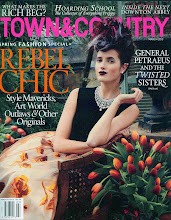 Photos Courtesy of Artisan
Photos Courtesy of Artisan

 What should you know when you buy a townhouse that needs a major renovation? Living in an Italianate brownstone in Brooklyn's Carroll Gardens, Ingrid Abramovitch knows a thing or two about townhouses. She became an expert on the subject when putting together her first book, Restoring a House in the City from Artisan. After getting to know Ingrid while we were at House and Garden, I found her thorough research and great writing as the Features Director awe inspiring. Everything she covered from design to lifestyle was done with exhaustive research-- extracting the most fascinating stories and details. She informed her reader on the said topic, and left them yearning for more.
What should you know when you buy a townhouse that needs a major renovation? Living in an Italianate brownstone in Brooklyn's Carroll Gardens, Ingrid Abramovitch knows a thing or two about townhouses. She became an expert on the subject when putting together her first book, Restoring a House in the City from Artisan. After getting to know Ingrid while we were at House and Garden, I found her thorough research and great writing as the Features Director awe inspiring. Everything she covered from design to lifestyle was done with exhaustive research-- extracting the most fascinating stories and details. She informed her reader on the said topic, and left them yearning for more. With her townhouse submersion she travelled far and wide, shooting twenty-one Federal, Colonial, Greek and Revival homes decorated in a range of styles. The surge in restoring homes in Brooklyn continues, and is happening in many neighborhoods she covers, from Savannah to Canada. Tips and ideas on what to do with an old home, how to restore period elements, and maintain the charm are imparted in information filled sections. The invaluable source guide in the back makes even the restoration neophyte feel more assured about the daunting process.
I spoke with Ingrid recently, and she shared her insights with me:
Why this book now?
Why this book now?
On a pure style level, what's old is in--from advertising to hotel and restaurant design, the flourishes and patina of Victoriana and nineteenth century architecture are very much in fashion. But I think there are more complicated reasons why restoring a period town house has gained in cachet. In the nineteenth century, when most of the homes in my book were built, a house in the city was the ultimate address. But then cities went out of favor and everyone moved to the suburbs. Many of these urban neighborhoods declined, and single-family homes were carved into apartments or boarding houses. Now we've come full circle. No one wants to live in the suburbs--they want a house in town, and those who have the means are turning these residences back into single-family houses. Nothing compares to a period town house in terms of the craftmanship and details--not to mention the luxury of a street address and a little bit of outdoor space in the middle of the city.
What was the one thing you did not know that you learned through putting this book together?
Lots of things, but this is interesting: the Charleston homeowners in the book, who undertook a meticulous restoration of their Greek Revival home, discovered they could apply for an interior easement for their home. Anyone can do this through their local preservation society or the National Trust for Historic Preservation. In other words, they have protected the inside of elements of their home from future alterations--even (or especially) from future owners. They saved the staircase, the medallions, the fireplaces, the shutters, and so forth. That's an amazing tool for preservation that few people know about.
What was your favorite project or room?
I looked at hundreds of projects and picked my favorite 21 houses. I was trying to find a group of houses that were all very different in style, architecture, and approach, all with a takeaway for the reader. I was also looking for geographic diversity. There are homes in ten cities, including Boston, Washington, DC, Philadelphia, and San Francisco.
What was the most transformed project?
Mark Borthwick, the photographer, and his wife, the fashion designer Maria Cornejo, bought a very derelict brownstone in Brooklyn and hired one of my favorite architectural firms, Fernlund + Logan, to create a two-storey glass addition consisting of putty-glazed factory windows. The interior architecture is very pristine and modern. One would never know it from the front of the house.
What eco green materials are people using more?
Low VOC paints, bamboo flooring, recycled stone counters, GREENGUARD-certified insulation to reduce heat loss. In my book, I try to encourage homeowners to recycle and reuse the elements that are already there. For instance, is there flooring in a closet or attic that can be remilled for use somewhere else in the house? These homes were built of first-growth wood--lumber from America's earliest forests. You can't beat it for durability and beauty. I also provide many resources in the book for sourcing reclaimed building materials and vintage fixtures.
What city and neighborhood is seeing the biggest revival?
There are neighborhood revivals happening in almost every city. I was in Philadelphia recently and was impressed with the wonderful restorations and design energy I witnessed in emerging neighborhoods like Northern Liberties. Last weekend, I did an event for my book in Bedford-Stuyvesant and went on their annual house tour. Those houses are amazing! There is a new Italian restaurant there, Saraghina, on the site of a former garage, that was assembled by an Italian movie set designer out of fragments of old buildings. It's so atmospheric--not to mention delicious.
What was the best before and after?
I think every house in the book came a very long way. So hard to choose.
How did you find the houses, through word of mouth, designers, etc?
As an editor at House & Garden for ten years before it closed, I had a good list of contacts in the architecture and design community. And I called them all! And asked everyone I knew in cities across North America for leads. I looked at hundred of projects, toured houses in each of the cities in the book, clipped articles, and even found one project on the Brooklyn Heights house tour near where I live. It took months to convince Julianne Moore to allow me to include her town house in the book.
What was the most bizarre way a project came to you?
A friend had gone trick-or-treating in Troy, New York, and came back raving about the brownstones there. Check out that house--a double-wide brownstone on a private gated square. It's like something out of Edith Wharton, and in fact, that's where Scorsese shot The Age of Innocence, using Troy as a stand-in for nineteenth-century New York.
What was the one thing you did not know that you learned through putting this book together?
Lots of things, but this is interesting: the Charleston homeowners in the book, who undertook a meticulous restoration of their Greek Revival home, discovered they could apply for an interior easement for their home. Anyone can do this through their local preservation society or the National Trust for Historic Preservation. In other words, they have protected the inside of elements of their home from future alterations--even (or especially) from future owners. They saved the staircase, the medallions, the fireplaces, the shutters, and so forth. That's an amazing tool for preservation that few people know about.
What was your favorite project or room?
I looked at hundreds of projects and picked my favorite 21 houses. I was trying to find a group of houses that were all very different in style, architecture, and approach, all with a takeaway for the reader. I was also looking for geographic diversity. There are homes in ten cities, including Boston, Washington, DC, Philadelphia, and San Francisco.
What was the most transformed project?
Mark Borthwick, the photographer, and his wife, the fashion designer Maria Cornejo, bought a very derelict brownstone in Brooklyn and hired one of my favorite architectural firms, Fernlund + Logan, to create a two-storey glass addition consisting of putty-glazed factory windows. The interior architecture is very pristine and modern. One would never know it from the front of the house.
What eco green materials are people using more?
Low VOC paints, bamboo flooring, recycled stone counters, GREENGUARD-certified insulation to reduce heat loss. In my book, I try to encourage homeowners to recycle and reuse the elements that are already there. For instance, is there flooring in a closet or attic that can be remilled for use somewhere else in the house? These homes were built of first-growth wood--lumber from America's earliest forests. You can't beat it for durability and beauty. I also provide many resources in the book for sourcing reclaimed building materials and vintage fixtures.
What city and neighborhood is seeing the biggest revival?
There are neighborhood revivals happening in almost every city. I was in Philadelphia recently and was impressed with the wonderful restorations and design energy I witnessed in emerging neighborhoods like Northern Liberties. Last weekend, I did an event for my book in Bedford-Stuyvesant and went on their annual house tour. Those houses are amazing! There is a new Italian restaurant there, Saraghina, on the site of a former garage, that was assembled by an Italian movie set designer out of fragments of old buildings. It's so atmospheric--not to mention delicious.
What was the best before and after?
I think every house in the book came a very long way. So hard to choose.
How did you find the houses, through word of mouth, designers, etc?
As an editor at House & Garden for ten years before it closed, I had a good list of contacts in the architecture and design community. And I called them all! And asked everyone I knew in cities across North America for leads. I looked at hundred of projects, toured houses in each of the cities in the book, clipped articles, and even found one project on the Brooklyn Heights house tour near where I live. It took months to convince Julianne Moore to allow me to include her town house in the book.
What was the most bizarre way a project came to you?
A friend had gone trick-or-treating in Troy, New York, and came back raving about the brownstones there. Check out that house--a double-wide brownstone on a private gated square. It's like something out of Edith Wharton, and in fact, that's where Scorsese shot The Age of Innocence, using Troy as a stand-in for nineteenth-century New York.

























3 comments:
Thanks for sharing, this looks like a great book with a unique point of view!
Best,
Jaime
As one who is renovating a house in a city, this book is perfect. Great post!
this looks like a great book with a unique point of view!
Work from home India
Post a Comment